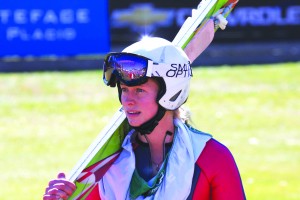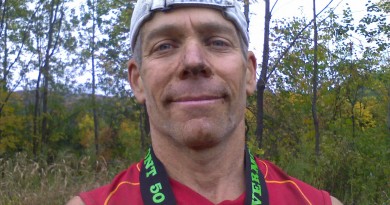Reader Athlete: Tara Geraghty-Moats
 Age: 21
Age: 21
Residence: Fairlee
Family: Mother, Elizabeth Geraghty
Occupation: Full-time athlete, part-time student
Primary sport: Ski jumping
Tara Geraghty-Moats started ski jumping at the age of nine and never looked back. She has competed internationally in both cross-country skiing and biathlon, but she’s looking forward to spending her first winter on the World Cup ski jumping circuit.
VS: What’s the appeal of ski jumping?
TGM: I love being in the air and I love the fact that it’s something kind of extraordinary. A lot of people look at ski jumping and think it looks pretty impossible. There’s a certain draw to a sport that gives you a thrill and not that many people can do.
VS: When did you start jumping?
TGM: I started when I was nine years old in Hanover and Lebanon, New Hampshire. Hanover has 10, 20 and 35 meter jumps and Lebanon has 10, 25 and 50 meter jumps. Ski jumping is a bit like gymnastics regarding the age time-line. You can start young, but you begin with jumps that are small and conservative like a three-meter jump. You progress step by step. By the time athletes get to the World Cup level it looks really dramatic, but it takes years and years of practice and small steps.
VS: How frustrating has it been to have limited competitions for women?
TGM: It’s been very frustrating. There is beginning to be an international level for Ladies Nordic Combined for younger girls, but I’m at the high end of the age bracket for that. The development curve is really slow since they’re taking a long term view of it. I’m very happy, though, that my ski jumping is progressing and I’ll be on the World Cup circuit this year.
VS: How have you advocated for more levels of competition for women?
TGM: I just like to let my athletic ability speak for itself. I worked on the petition for the International Olympic Committee, but it’s really the generation that’s a little older than me that did more. I grew up jumping and trained hard and enjoyed the sport and that’s mostly what I’ve done. I do like to encourage the next generation of girls to jump. This summer I coached at summer camps in Lake Placid and Park City, Utah.
VS: You also compete in cross-country skiing, don’t you?
TGM: I do every winter sport I can, whenever I can. I love being outdoors and feel that every kind of skiing helps another kind of skiing. I started competing in cross-country skiing when I was eight and I started biathlon when I was 17. I went to Junior Worlds four times for biathlon during the years that I had to give up ski jumping due to injury. [Geraghty-Moats broke her leg and tore ligaments in a training crash in 2009].
VS: But this year it’s just ski jumping, isn’t it?
TGM: This winter will be my first time competing in just one sport. I’ll start off with training camp in Slovenia and Germany and then the first World Cup competition will be in Norway. If that goes well, I’ll compete in Japan, Slovenia and Austria, but that will depend on the first few competitions.
VS: Tell us about your most memorable competition?
TGM: I think the most memorable was when I was 16 and competing in Park City. I wasn’t on the national team at the time but I was competing against other team members on the 90-meter jump in the summer nationals. It was the first time I podiumed at an event like that. It sparked my interest to take ski jumping all the way and to compete internationally.
VS: What international competitions have you done?
TGM: I was on the Continental Cup ski jumping circuit for a while, but because of my injury I had to take four years off so I haven’t jumped internationally yet.
VS: How did you spend your summer?
TGM: Since I’m only training for ski jumping right now I spent the summer in Lake Placid and Utah training. It’s the same equipment but you land on plastic and it’s really very comparable to snow. Ski jumping is a year-round sport now, although I take a little bit of a break in the spring and a short break in the fall. People think landing on the plastic must be rough, but it doesn’t hurt. The hill is steep so it’s more like landing on a slide. It doesn’t matter what you land on, you’re not crunching to a stop. It’s not the most dignified thing when you fall, but it’s not a big deal.
VS: Is it difficult to find women’s skis?
TGM: The equipment is exactly the same except for length. Since every ski jumper starts small, I just have shorter skis than the taller men. Now that I’m at a higher level my skis might need to be more flexible than those for guys my age, but it’s just small details.
VS: Where do you go to school?
TGM: I take on-line classes at Community College of Vermont through the Vermont State College network and with DeVry University, which has a partnership with the U.S. Ski Team.
VS: Where do you see yourself in a few years?
TGM: I have to see how things go on the World Cup circuit this winter. There are 16-year-olds winning medals, but last year there was also a 40-year-old silver medalist. There’s no age limit for ski jumping; its how every individual feels and how their life is going. I’ll do this for as long as it’s fun and my body feels good. I’ll also continue going to school with a goal of sports science, coaching or maybe being an EMT. Right now just going to classes and focusing on school is an important part of my life.
VS: Do you ever get to ski for fun?
TGM: I ski at Mad River Glen a lot. I grew up skiing there and they’re helping to support me this winter. It’s something I really love to do and Mad River is where I developed my love for downhill skiing. Whether it’s there or in the backyard with friends and family, skiing is more than a job. It’s my life and I love what I do.
VS: Do you have other sponsors?
TGM: I do. The U.S. Women’s Ski team has a lot of sponsors, but we also do individual fundraising. The U.S. Ski Team has helped set up a framework to help us but we are virtually the only country on the ski circuit without government funding. It’s an interesting set up and it’s not ideal.

